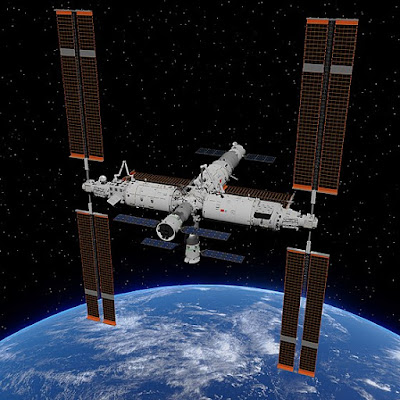• As we say goodbye to 2024, it's the ideal opportunity to reflect on humanity's remarkable progress in space exploration. This year has been full with historic accomplishments, ground-breaking missions, and discoveries that have broadened our understanding of the universe.
• Let's take a deeper look at the top ten space missions of 2024, each one demonstrating human ambition, curiosity, and drive to explore the unknown.
1. Chandrayaan-3, India's Moon mission.
• India's Chandrayaan-3 mission made news in 2024 for successfully landing near the Moon's south pole, a previously unexplored region. The mission's goal was to investigate the lunar surface and research its composition, with an emphasis on the south pole, which has the potential for water ice.
Highlights: The Pragyan rover conducted tests and transmitted significant data on lunar materials to the global scientific community.
Why It's Special: This mission made India the first country to land near the Moon's south pole, a key milestone in space exploration.
2. Mars Sample Return: A Red Planet Milestone.
• The Mars Sample Return mission, a NASA-ESA collaboration, made a big leap in 2024, paving the way for the first return of Martian soil and rocks to Earth. The goal is to gather samples obtained by NASA's Perseverance rover from the Martian surface and bring them to Earth for further study.
Highlights: In 2024, the mission successfully obtained Martian samples, with plans to return them to Earth in 2033.
Why It's Special: These samples will provide crucial insights on the likelihood of ancient life on Mars, allowing us to better comprehend the planet's history.
3. James Webb Space Telescope Unveils Exoplanets.
• The James Webb Space Telescope (JWST) continued its ground-breaking work in 2024, providing breathtaking new views of the universe and uncovering mysteries about distant exoplanets. JWST's major mission is to study the earliest galaxies and find exoplanets that could host life.
Highlights: In 2024, JWST found water vapor in the atmosphere of an exoplanet positioned in its star's habitable zone, indicating the possibility of life.
Why It's Special: JWST is at the forefront of discovering new worlds and addressing one of humanity's most pressing questions: are we alone in the universe?
4. SpaceX's Starship is Revolutionizing Space Travel.
• SpaceX's Starship made a significant advancement in 2024 by successfully completing its first orbital test flight, a vital milestone in the building of the world's most powerful spacecraft. The goal of Starship is to create a fully reusable spacecraft capable of long-term journeys to the Moon, Mars, and beyond.
Highlights: The successful test flight confirmed Starship's capabilities to conduct deep space trips and significantly reduce the cost of space travel.
Why It's Unique: With Starship, SpaceX is pushing the limits of space technology, making space travel more inexpensive and accessible for future generations.
5. JUICE: A Journey to Jupiter's Ice Moons
• The European Space Agency launched the JUICE (Jupiter Icy Moons Explorer) mission, which will reach Jupiter in 2024. Goal: Explore Jupiter's three largest moons, Europa, Ganymede, and Callisto, and examine their possibility for life.
Highlights: JUICE is on its way to Jupiter and will arrive in 2031, but the data and photographs captured throughout its trip are already generating excitement.
Why It's Special: By studying these moons, JUICE hopes to reveal critical knowledge regarding cold worlds and their ability to support life.
6. Construction Progress for the Lunar Gateway
• The Lunar Gateway, a vital component of NASA's Artemis program, continued to progress in 2024, with key pieces launched and assembled in space. The Gateway space station will orbit the Moon and serve as a staging platform for missions to the lunar surface and beyond.
Highlights: The successful launch and assembly of numerous modules paved the way for long-term lunar exploration.
Why It's Special: The Lunar Gateway is a vital component of humanity's desire to establish a long-term presence on the Moon and pave the way for future trips to Mars.
7. China's Tiangong Space Station Expansion
• China's Tiangong Space Station expanded significantly in 2024, with additional modules and experiments strengthening the country's space capabilities. Tiangong operates as a space-based research laboratory, conducting studies in subjects including as biology, astronomy, and physics.
Highlights: China launched new modules and conducted important scientific tests to better understand how life adjusts to living in space.
Why It's Special: Tiangong's achievement highlights China's growing status as a significant actor in space exploration.
8. Rocket Lab's Venus mission
• Rocket Lab, a private space business, will send its first mission to Venus in 2024 to explore the planet's hostile atmosphere. The mission's goal was to better understand the composition of Venus' atmosphere and whether it formerly hosted life.
Highlights: Rocket Lab's small, low-cost spacecraft completed a flyby of Venus, gathering crucial data.
Why It's Special: This expedition demonstrated how private corporations are increasingly involved in space research, paving the way for new frontiers in planetary science.
9. OSIRIS-REx: Asteroid Sample Analysis.
• NASA's OSIRIS-REx spacecraft made substantial progress in 2024, analyzing asteroid samples acquired from Bennu. The goal is to examine the samples for clues concerning the beginnings of life and the building elements of the solar system.
Highlights: The data returned from the asteroid revealed fascinating details about Bennu's composition and structure.
Why It's Special: These findings will help scientists learn more about the early solar system and the possibility of life on distant planets.
10. Europa Clipper: Unlocking the Secrets of Jupiter’s Moon
• NASA's Europa Clipper project made news in 2024 when it launched its trip toward Jupiter's moon Europa, a critical target in the quest for life beyond Earth. The goal is to study Europa's ice surface and research its underlying ocean, which may contain conditions conducive to life.
Highlights: The spacecraft is outfitted with cutting-edge instruments meant to study Europa's surface and innards.
Why It's Special: Europa Clipper's mission is crucial to understanding the possibility of life on other planets, particularly those with deep oceans like Europa.







.jpg)







.jpeg)

0 Comments